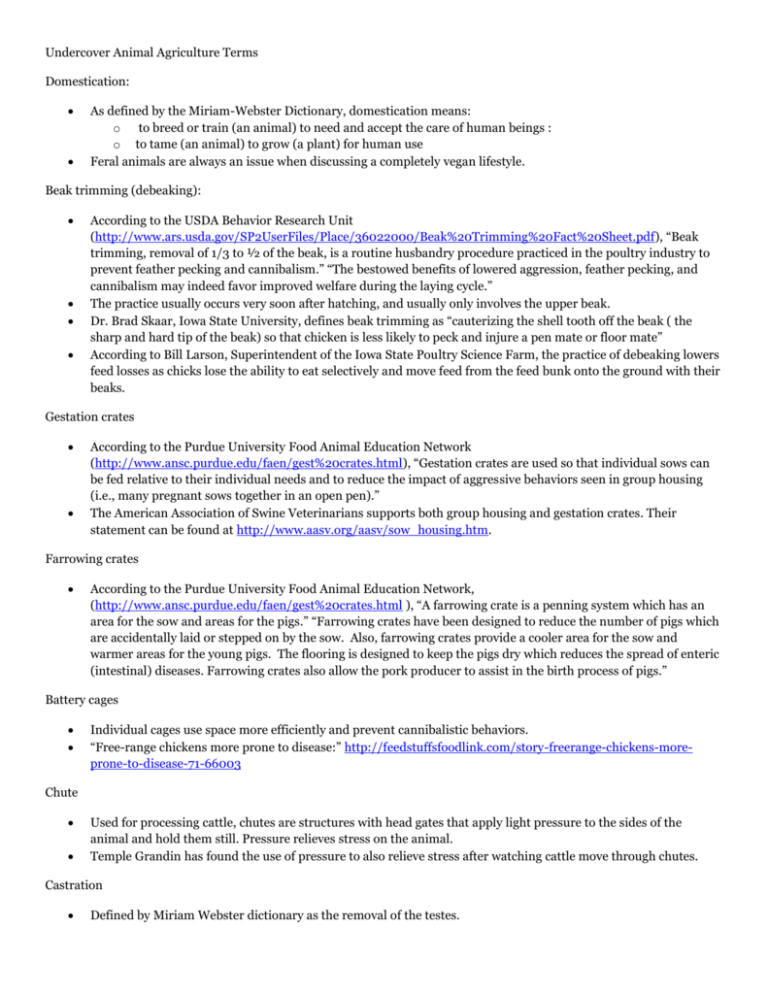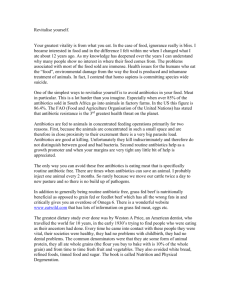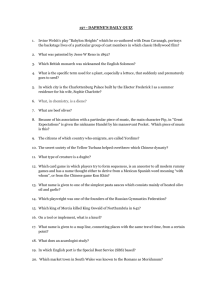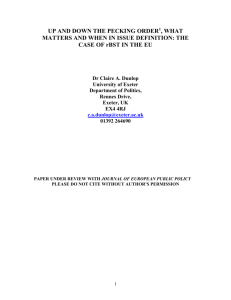SAI Presentation Definitions and information - SAI
advertisement

Undercover Animal Agriculture Terms Domestication: As defined by the Miriam-Webster Dictionary, domestication means: o to breed or train (an animal) to need and accept the care of human beings : o to tame (an animal) to grow (a plant) for human use Feral animals are always an issue when discussing a completely vegan lifestyle. Beak trimming (debeaking): According to the USDA Behavior Research Unit (http://www.ars.usda.gov/SP2UserFiles/Place/36022000/Beak%20Trimming%20Fact%20Sheet.pdf), “Beak trimming, removal of 1/3 to ½ of the beak, is a routine husbandry procedure practiced in the poultry industry to prevent feather pecking and cannibalism.” “The bestowed benefits of lowered aggression, feather pecking, and cannibalism may indeed favor improved welfare during the laying cycle.” The practice usually occurs very soon after hatching, and usually only involves the upper beak. Dr. Brad Skaar, Iowa State University, defines beak trimming as “cauterizing the shell tooth off the beak ( the sharp and hard tip of the beak) so that chicken is less likely to peck and injure a pen mate or floor mate” According to Bill Larson, Superintendent of the Iowa State Poultry Science Farm, the practice of debeaking lowers feed losses as chicks lose the ability to eat selectively and move feed from the feed bunk onto the ground with their beaks. Gestation crates According to the Purdue University Food Animal Education Network (http://www.ansc.purdue.edu/faen/gest%20crates.html), “Gestation crates are used so that individual sows can be fed relative to their individual needs and to reduce the impact of aggressive behaviors seen in group housing (i.e., many pregnant sows together in an open pen).” The American Association of Swine Veterinarians supports both group housing and gestation crates. Their statement can be found at http://www.aasv.org/aasv/sow_housing.htm. Farrowing crates According to the Purdue University Food Animal Education Network, (http://www.ansc.purdue.edu/faen/gest%20crates.html ), “A farrowing crate is a penning system which has an area for the sow and areas for the pigs.” “Farrowing crates have been designed to reduce the number of pigs which are accidentally laid or stepped on by the sow. Also, farrowing crates provide a cooler area for the sow and warmer areas for the young pigs. The flooring is designed to keep the pigs dry which reduces the spread of enteric (intestinal) diseases. Farrowing crates also allow the pork producer to assist in the birth process of pigs.” Battery cages Individual cages use space more efficiently and prevent cannibalistic behaviors. “Free-range chickens more prone to disease:” http://feedstuffsfoodlink.com/story-freerange-chickens-moreprone-to-disease-71-66003 Chute Used for processing cattle, chutes are structures with head gates that apply light pressure to the sides of the animal and hold them still. Pressure relieves stress on the animal. Temple Grandin has found the use of pressure to also relieve stress after watching cattle move through chutes. Castration Defined by Miriam Webster dictionary as the removal of the testes. Ryan Goodman, Montana Rancher and blogger (http://agricultureproud.com/2011/05/12/why-castrate-cattle/ ) explains that castration controls inferior breeding and lower testosterone in the steer leads to more favorable texture and flavor in meat. Supplemental Hormones Synthetic hormones that are injected, implanted, or otherwise given to the animal. According to the USDA at http://1.usa.gov/1n7VsBs, it is illegal to use supplemental hormones in raising poultry or pigs. According to the USDA, it is legal to use supplemental hormones in raising beef. “What’s the beef? M&M’s and hormones” http://nefb.wordpress.com/2013/08/23/whats-the-beef-mms-andhormones/ “Facts about hormones and beef” – Drover’s Cattle Network http://www.cattlenetwork.com/cattlenews/169217746.html “Scientific authorities agree that use of hormone implants results in the efficient production of beef that is safe.” Montana State University Beef Specialist John Paterson. http://animalrangeextension.montana.edu/Articles/Beef/Wklynwsltr/12-19.01.htm Antibiotics According to the United States Farmers and Ranchers Alliance (http://www.fooddialogues.com/foodsource/antibiotics) , “Some farmers and ranchers use antibiotics to promote lean muscle production in animals. In 2007, this accounted for about 13 percent of antibiotic use. As part of the efforts to minimize future risk of antibiotic treatment failure in humans, antibiotics important to human medicine used for growth purposes in food animals will be eliminated within three to four years in accordance with the FDA Guidance 209 and 213 (FDA). (Note: the exact timing depends on the final issuance of the FDA guidelines expected in 2013).” “In humans, doctors tend to treat the individual. In farm animals, veterinarians tend to treat the herd.” – USFRA “Although there has been no proven link to antibiotic treatment failure in humans due to antibiotic use in animals for consumption, they are working to minimize future risk.” - (Hurd SH, Doores S, Hayes D, Mathew Am Maurer J, Silley P, Randall SS and Jones RN (2004). Public Health Consequences of Macrolide Use in Food Animals: A Deterministic Risk Assessment. Journal of Food Protection, 67( 5): 980–992.) “No residues from feeding antibiotics are found in beef, and there is no valid scientific evidence that antibiotic use in cattle causes illness resulting from the development of antibiotic-resistant bacteria. Scientific authorities agree that use of hormone implants results in the efficient production of beef that is safe.” – Montana State University Beef Specialist John Paterson. http://animalrangeextension.montana.edu/Articles/Beef/Wklynwsltr/1219.01.htm All meat in the food stream is antibiotic free. Dr. Scott Hurd of Iowa State University explains this and his studies in his blog, http://hurdhealth.com/2013/08/14/its-all-antibiotic-free-baby/ According to Dermot Hayes and Helen Jensen of Iowa State, following a pre-emptive, feed-grade antibiotic ban in Denmark, resistance to human-use antibiotics increased following a large increase in human-use antibiotics to treat animals after they became sick. http://lib.dr.iastate.edu/cgi/viewcontent.cgi?article=1002&context=econ_las_pubs All in, all out Process of moving groups of hogs at the end of each value-added step to maintain hygiene, improve on-farm animal flow and break the cycle of disease transmission. Grass-fed USDA Definition of grass-fed: “Grass and forage shall be the feed source consumed for the lifetime of the ruminant animal, with the exception of milk consumed prior to weaning. The diet shall be derived solely from forage consisting of grass (annual and perennial), forbs (e.g., legumes, Brassica), browse, or cereal grain crops in the vegetative (pre-grain) state.” “However, researchers in Texas A&M University’s Department of Animal Science have published the only two research studies that actually compared the effects of ground beef from grass-fed cattle and traditional, grain-fed cattle on risk factors for cardiovascular disease (CVD) and type II diabetes in men. Was ground beef from grassfed beef actually more healthful? No, the study found.” – Stephen B. Smith, Texas A&M University http://m.beefmagazine.com/beef-quality/grass-fed-vs-grain-fed-ground-beef-no-difference-healthfulness Top 10 myths about grass-fed beef: http://factsaboutbeef.com/2012/10/10/is-grass-finished-or-grain-finishedbeef-better/ Cage free “This label indicates that the flock was able to freely roam a building, room, or enclosed area with unlimited access to food and fresh water during their production cycle.” http://1.usa.gov/TKgltK Realfarmersrealfood.com (related to the Animal Agriculture Alliance) states that “a study, by Dr. Kenneth Anderson at NC State University, showed essentially no differences in nutritional quality. The results show that housing did not play apart on the levels of Vitamin A, or Vitamin B found in the eggs. ‘The key take away is that an egg, no matter where it’s produced, is an extremely nutritious product.’” “A recent report published by Feedstuffs shows there are no difference in cholesterol levels between organic and regular eggs. However the study did conclude that contamination with Salmonella and other food-poisoning organisms is not consistently different between organic and regular eggs and may be higher in organic eggs.” http://feedstuffsfoodlink.com/story-are-organic-eggs-safer-healthier-74-71784 Free range “This label indicates that the flock was provided shelter in a building, room, or area with unlimited access to food, fresh water, and continuous access to the outdoors during their production cycle. The outdoor area may or may not be fenced and/or covered with netting-like material. This label is regulated by the USDA.” http://1.usa.gov/TKgltK Downer A down cow is a cow that is sick or injured and will not or cannot get up. The longer the cow lays on her legs, the less circulation reaches them. The longer a cow is down, the less likely it is that she will ever get up. Dairy Carrie, a dairy farmer, does a good job of explaining what happens with downer cows in her blog post, “Sometimes We Are Mean to Our Cows.” http://dairycarrie.com/2013/12/09/cowabuse/ rBST bST stands for Bovine somatotropin, and is a protein hormone produced by the pituitary gland of cows. “One benefit from the use of rBST is that supplemented cows require less feed per unit of milk produced.” – Dale E. Bauman and Robert J Collier, Cornell University and University of Arizona “…rBST use in dairy production mitigates environmental parameters including eutrophication and acidification potentials, greenhouse gas emissions, and fossil fuel use.” - Dale E. Bauman and Robert J Collier, Cornell University and University of Arizona “The best indication of the health and well-being of a dairy cow is her own performance. If cows are stressed or ill, then milk yield is reduced. The performance of cows receiving rBST is exactly the opposite – they produce more milk and are able to utilize nutrients more efficiently.” - Dale E. Bauman and Robert J Collier, Cornell University and University of Arizona According to Dale E. Bauman and Robert J Collier, Cornell University and University of Arizona, bST is not biologically active in humans even if injected directly into the bloodstream, and milk from rBST-supplemented cows does not differ in compostition from milk produced by unsupplemented cows. rBST has been studied in animals, starting with lab rats, since the 1920’s. http://www.ansci.cornell.edu/bauman/envir_impact/rbst_booklet.html#History CAFO – Concentrated Animal Feeding Operation A CAFO is defined by the EPA as “an agricultural operation where animals are kept and raised in confined situations. CAFOs congregate animals, feed, manure and urine, dead animals, and production operations on a small land area. Feed is brought to the animals rather than the animals grazing or otherwise seeking feed in pastures, fields, or on rangeland.” Illinois Farm Families Field Mom approaches the subject of CAFO’s after visiting Larson Farms. http://www.watchusgrow.org/BlogRetrieve.aspx?BlogID=419&TagID=134373








